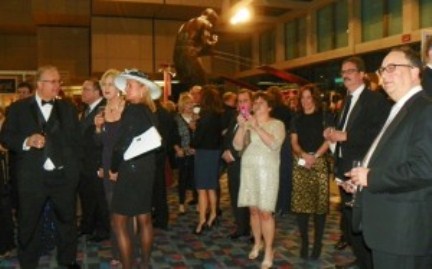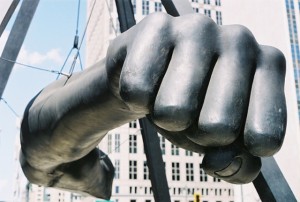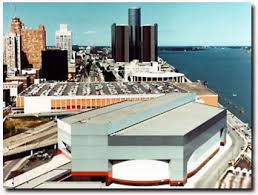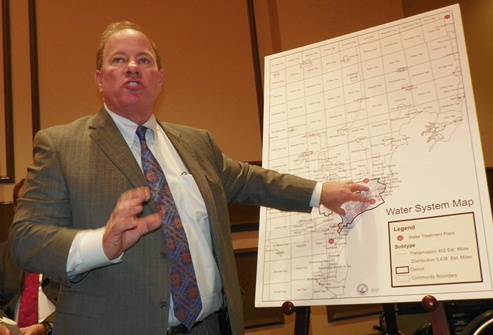
Lawyers and financial advisors for the City of Detroit (meaning EM Kevyn Orr, seated center) and creditor FGIC, gather with mediator Judge Gerald Rosen (to left of Orr) after reaching proposed deal, at 2 a.m. Oct. 16, 2014. Bloomberg did not even identify Orr in this courtesy photo.
DETROIT CREDITORS SEEKING CASH WILL SETTLE FOR “THE JOE”
By Steven Church and Chris Christoff
Oct 16, 2014 5:47 PM ET Bloomberg
(Headline at very top is by Voice of Detroit. VOD analysis in the works. These creditors should instead be going to jail under the RICO act for conspiracy to commit fraud, along with lenders UBS, BOA, SBS Financial, and various others. Former Detroit CFO Sean Werdlow among other city officials should also be indicted. The creditors’ claim is based on the disastrous $1.5 billion COPS loans of 2005-06. As part of this deal, the “City” –meaning Kevyn Orr/Jones Day–will withdraw its lawsuit against the loan, in which it called the deal “void ab initio, illegal and unenforceable.” In an independent analysis, Wallace Turbeville of DEMOS concurred, and went further to declare the Detroit bankruptcy a hoax.)
DETROIT — A milestone agreement in Detroit’s record bankruptcy requires its last major creditors to help revitalize the city’s downtown in return for cutting their losses from a $1.4 billion pension deal that went sour.
Financial Guaranty Insurance Co. would indirectly own and pay to redevelop the riverfront site of Joe Louis Arena — home of the National Hockey League’s Detroit Red Wings — which will be demolished in 2017 when a new arena opens a mile away. FGIC would also get a share of $141.4 million in new notes in a deal announced today in federal court in Detroit.
The agreement brings the city closer to resolving its $18 billion bankruptcy, and would put a group of creditors that includes Aurelius Capital Management LP and and BlueMountain Capital Management LLC, owed about $1.1 billion, in charge of building a hotel and retail space in a downtown that city leaders view as a linchpin of economic recovery.
“There wasn’t any more cash,” Mayor Mike Duggan said in an interview. “They made an assessment that their best chance for a return was to participate in Detroit’s redevelopment.
‘‘The more successful their development is, the more of their claim they get back. It’s great for both of us.”
The deal is modeled on one the city struck with another bond insurer, Syncora Guarantee Inc. Both companies insured $1.4 billion of pension debt that won’t be repaid under the city’s debt-cutting proposal.
Instead, the bond insurers would collect cash, notes and land that they would use to help pay the pension debt holders. Depending on the structure of the final deal, Aurelius and the other investors would indirectly own from 83 percent to more than 90 percent of the land under the FGIC deal.
No Deal
The debt holders have not yet agreed to a deal, but may do so in the next few days, said their attorney, Thomas Moers Mayer.
Requiring creditors to invest more in the city is at least rare, and may be unprecedented in a municipal bankruptcy, attorney James E. Spiotto said in an interview. The deal resembles a corporate restructuring, he said.
“To some degree it’s a lot like Chapter 11, where they are giving them a chance to buy equity in the debtor,” Spiotto said. “They have to put something into it to get something out.”
Mayer said the arena and its parking garage would be owned by a trust for the benefit of the debt holders and managed by FGIC.
‘The Joe’

- Statue of Joe Louis at Cobo Hall, also given away to regional authority, with back turned to wealthy elite celebrating Auto Show Jan. 18, 2013.
Nicknamed “The Joe,” the hulking, windowless edifice was built by the city in the late 1970s to keep the Red Wings from moving to a suburb. It was host for the 1980 Republican National Convention, where Ronald Reagan was nominated candidate for president.
Built as part of a downtown revitalization plan, it now will give way to another one 35 years later.
The redeveloped site would book-end a commercial-entertainment district with a $650 million development anchored by the new hockey arena to the north. That project, led by billionaire Mike Illitch, owner of the Red Wings, also would include a hotel, residential housing and retail establishments.
While Detroit continues to lose population, 10,800 jobs have been added in the central business district since 2010, when 52,100 employees worked in the area, according to the Southeast Michigan Council of Governments.
Clearing Blight

- Sculpture in black of Joe Louis’ fist in downtown Detroit. To many Black Americans, Joe Louis represented the defeat of white supremacy, now embodied in “blight (Black) removal” plans.
The settlement would enable Detroit to carry out a rebuilding program that calls for spending of at least $440 million clearing blight from troubled neighborhoods.
During the hearing, Mayer told U.S. Bankruptcy Judge Steven Rhodes that the hedge funds pulled out last night when they learned of a last-minute change in the proposal.
Mayer said in an interview that his clients were ready to join the deal last night when they learned that an upfront cash payment of about $171 million would instead be spread out over several years.
Whether the hedge funds get the payment up front or over time, they are still getting more than what Detroit had initially proposed, Mayer said. The city had estimated pension bondholders would get back no more than about 10 percent of the $1.4 billion they are owed.
FGIC and the bondholders would have three years to build a hotel and the retail center on the site. The development may be completed by 2022, said Corinne Ball, a lawyer for the city.
Three Approvals
The deal needs at least three approvals before it’s final. New York state regulators that oversee FGIC must sign off, as must the Detroit city council or, if the council rejects it, a Michigan loan board that helps oversee Detroit’s finances. Rhodes has the final say on the settlement and the overall plan, which would shed about $7 billion of debt.
Detroit already reached settlements with other creditors, including public pension systems, under court-supervised mediation in the past year.
Rhodes scheduled a hearing for next week, saying he still plans to hear testimony from a court-appointed expert hired to examine the city’s proposal.
Detroit filed for bankruptcy in July 2013, following decades of decline. The city listed $18 billion in liabilities and said it couldn’t meet its financial obligations while still providing necessary services to the public.
At the center of the plan is an agreement with the state of Michigan and large philanthropies to protect Detroit’s art collection in exchange for hundreds of millions of dollars to shore up public pension funds. Some opponents said the art should be sold or used to secure loans to repay creditors.
FGIC agreed to drop all its objections to the plan under the deal.
“We are happy to report what has seemed like Detroit’s own version of the Gordian knot has been cut,” Ball said today in court. “We now have it done.”
The case is In re City of Detroit, 13-bk-53846, U.S. Bankruptcy Court, Eastern District of Michigan (Detroit).







